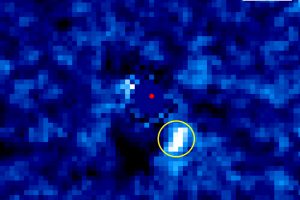
Typically, planets did not form at the distance from their central stars where we observe them today. In fact, during their early evolution, planets migrate from their initial orbit until the system reaches its final configuration. Planetary migration can be induced by several processes: the interaction between the newborn planets and the protoplanetary disk where they formed, the gravitational interaction between the planets in the system, perturbations due to close fly-bys, the interaction with companions in binary and multiple systems, and tidal effects. To observe exoplanets close to the location where they formed, it is necessary to conduct searches for exoplanets around stars younger than a few hundred million years.
There aren’t many young exoplanetary systems identified so far. This is primarily due to the intense magnetic activity of young stars, which generates signals that can hinder our ability to detect their planets. Among the very young stars with identified exoplanets, there are V1298 Tau, which is just over 20 million years old, and AU Mic (22 million years old), where an extended dust disk has been observed by the Hubble Space Telescope.
In the context of searching for exoplanets around young stars, a team of researchers led by astrophysicist S. Desidera from the INAF – Astronomical Observatory of Padua has analyzed an extensive set of observations of the star TOI-179 (HD 18599), which is a candidate for hosting an exoplanet. This dataset includes photometric observations from the NASA TESS satellite at three different time cadences (30, 10, and 2 minutes), necessary for constructing the light curve of the system (the temporal variation of the source brightness) and identifying exoplanets transiting in front of their stars. Alongside TESS data, the team also analyzed: 40 spectroscopic observations obtained with the HARPS spectrograph mounted on the 3.6m telescope of the European Southern Observatory (ESO), which allowed them to derive radial velocity curves and observe the oscillations of the central star due to gravitational interaction with its exoplanets; archival data used for characterizing the star; and specific observations using the SPHERE instrument at the Very Large Telescope of ESO. SPHERE, with its adaptive optic (a mirror whose geometry can be adjusted to correct atmospheric turbulence effects) and coronagraph (a device that obscures the central star to reveal the emission of faint nearby sources), enables astronomers to obtain direct images of exoplanets and low-mass companions.
These observations enabled astronomers to characterize TOI-179, a K2 star that is 400 million years old, and its planet (TOI-179 b). The planet has a mass equivalent to 20 Earth masses and a radius 2.6 Earth radii, and it orbits with a quite eccentric trajectory. This eccentric orbit of TOI-179 b may result from interaction with a low-mass companion, discovered thanks to SPHERE. This object has a mass of 83 Jupiter masses, and its orbit is not yet well determined. The authors present two possible solutions: a highly eccentric orbit with a period between 20 and 40 years, or a low-eccentricity orbit with a period between 100 and 120 years. Subsequent observations will allow for a determination of its orbit and a better understanding of how this object might perturb the orbit of TOI-179 b.
The figure (click here to view it in its entirety) displays the SPHERE image of TOI-179. The central star is obscured by the coronagraph, enabling the identification of the low-mass companion, indicated by a yellow circle. Its distance from the central star is 3.3 astronomical units.
Mario Giuseppe Guarcello ( follow mariospiegacose) ( mariospiegacose) ( follow mariospiegacose)
Follow the Astronomical Observatory of Palermo on Facebok and on Instagram
Subscribe the Youtube channel of the Astronomical Observatory of Palermo

